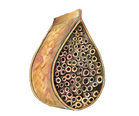|
Build a Bee House
Conservation Activity A learning activity by Tom J. McConnell, Ball State University. Produced for Conservation Tales: Bees (2017) Bees are an important part of our habitat! You may have seen honeybee hives at an apple orchard or a farm, but did you know you can build a simple bee house that gives OTHER types of bees a place to nest?
Many of the native bee species (not honeybees) nest in holes in the ground, in wood, or in plant stems. Around our homes, their nest sites often are destroyed by people. |
|
You can build a bee house that helps restore nesting sites for bees like carpenter bees, leaf cutter bees, digger bees, and many others! These houses are easy to build, and can bring more pollinators to your yard. This helps flowers and vegetables in your yard and garden, so it helps in many ways!
There are many designs for homemade bee houses! Find one you like, and build a bee house at home or for your school! When you've built the house, find a good place to put it, and wait through the summer to see what happens. You'll probably find that by fall, bees are nesting. You can watch them work, too! (Yes, it's safe!! Many of the solitary bees that nest in these holes cannot sting or are not aggressive! Give them a little space, and they will not hurt you!) Objectives:
Links to Bee House Plans
Build a Bee House - Try these sites for instructions! EXTENDING THE LEARNING:
After building your bee house, find a place to put the house in your yard. Ideal places might be on a post near a flower bed, or on the side of a garden shed under the eaves to shelter the house from rain. Then spend the next 6 months occasionally watching the bee house for signs that bees are beginning to build nests. When you do, draw pictures or take photos, and keep track of how many holes are being filled by nesting bees. You can even use links to bee identification pages to find out what kind of bees are nesting in your bee house! (Don't worry! If you are careful not to disturb the bees, they will not sting you!) And in the winter, you need to put the bee house in a shed or garage when the temperatures drop below 15˚ F or so. Bring the nest out again the spring to let any larva hatch when the weather warms.
|
For the Teacher Grade Level: 3-10 Class Periods: 1-2 NGSS Standards Student Expectations
Scientific knowledge is based on empirical evidence. |


